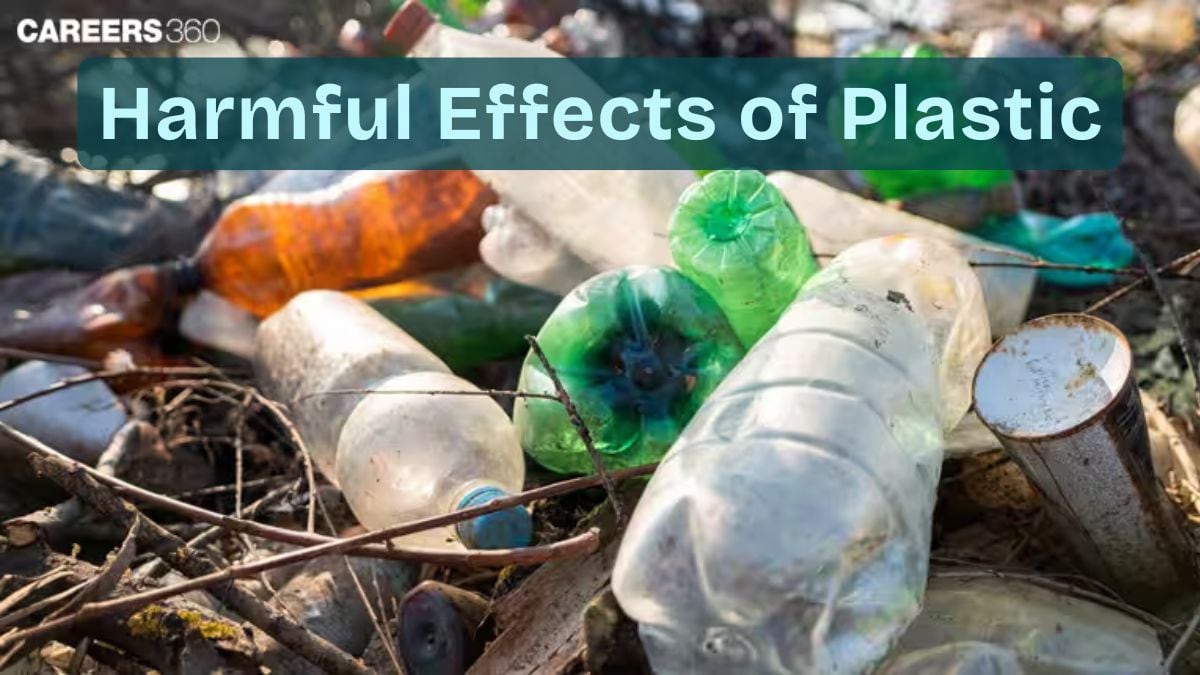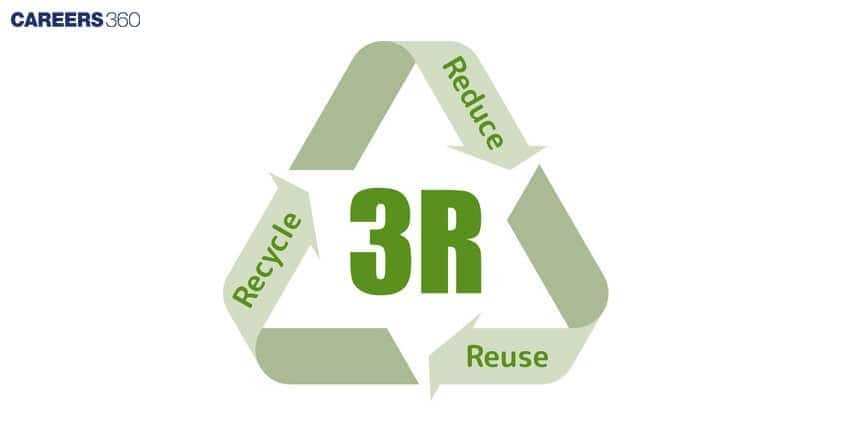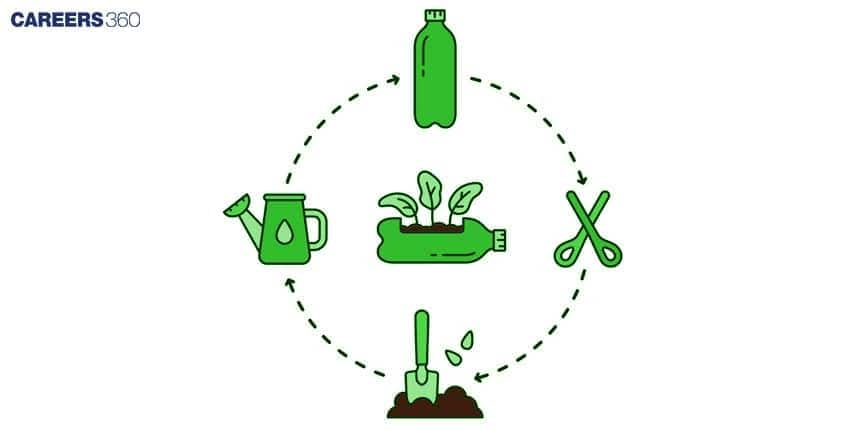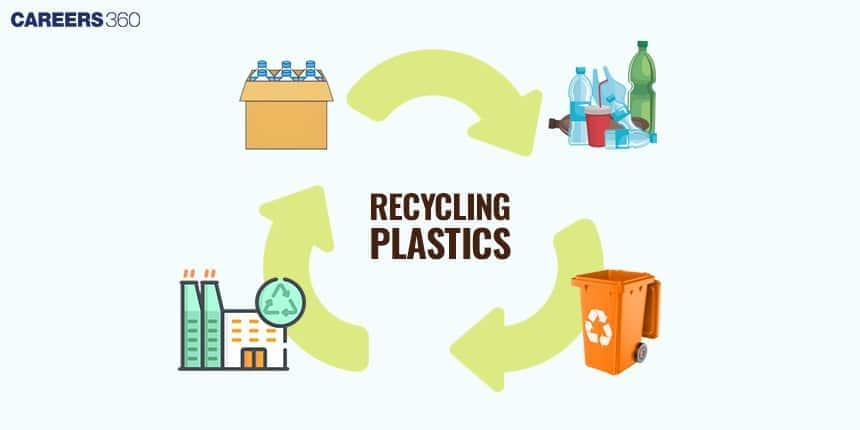Harmful Effects of Plastic: Definition, Types, Causes, Examples, Effects, Control
Plastics are petroleum-based materials valued for durability and low cost, but their non-biodegradable nature causes long-term environmental damage. They fragment into microplastics, contaminate ecosystems, harm wildlife, and contribute to climate change through production and disposal. This guide explains the harmful effects of plastic, health and ecological risks, 3R waste management, and NEET-focused notes.
This Story also Contains
- Why Is Plastic Harmful?
- Major Harmful Effects of Plastic
- Plastic Waste Management
- The 3R Principle (Reduce, Reuse and Recycle)
- Case Studies and Examples
- Harmful Effects of Plastic NEET MCQs (With Answers & Explanations)

Why Is Plastic Harmful?
Plastics are products drawn from petroleum-based mostly fossil fuel and largely non-biodegradable. While plastic becomes a boon in terms of durability, its bane shows up in terms of environmental consequences. Plastic does not degrade like other organic materials. It breaks down further into smaller particles named microplastics. The plastic pollutes ecosystems from the depths of the oceans to the highest mountain heights. This persistence contributes greatly to environmental pollution, disturbing natural habitats and risking biodiversity.
Major Harmful Effects of Plastic
Major harmful effects of plastic includes:
Environmental Pollution
Plastic waste pollutes ecosystems and creates sustained environmental hazards.
It alters habitats and disrupts ecosystems.
Impact on Marine Life
Sea creatures tend to ingest plastic, considering it as food.
They can fatally die or get suffocated.
It can lead to reproductive disorders and weakened immunity.
Microplastics
These are small plastic particles that accumulate in the oceans
They are ingested by marine life, reaching our food chain.
Toxic Chemical Leaching
Inimical chemicals from plastics leach into the soil and water.
Thus threatening wildlife and humans.
Some of the chemicals are carcinogenic or disrupt the endocrine system.
Global Warming and Climate Change
Plastic production depends on fossil fuel extraction.
Manufacturing and burning plastics emit greenhouse gases.
Contributing significantly to climate change.
Visual Pollution
The natural landscapes and scenic spots are polluted by plastic litter.
Affecting scenic beauty and tourism.
Health Hazards
The chemicals in plastic cause reproductive problems and carcinogenic effects.
Toxins bioaccumulate through food chains.
Economic Impact
The world spends billions on cleaning up plastic waste and to reverse these impacts.
Loss in fisheries and tourism and increased cost of public health.
Long-term Persistence
Most plastics do not break down.
Instead persist in the environment for hundreds of years.
Plastic Waste Management
Good management of plastics is very necessary to reduce their negative effects on the environment and human health. Principally, these are the concepts constituting the line of effective strategies: reduce, reuse, and recycle.
The 3R Principle (Reduce, Reuse and Recycle)
The 3R principle means reduce, reuse and recycle. This principle helps highlights sustainable ways of protecting the environment.

Reduce
The reduction of plastic use begins with awareness campaigns through education and other policies that reduce the use of single-use plastics for sustainable alternatives. In doing this, since the demand for disposable plastics will be reduced, the accumulation of plastic waste and its consequent effects on the ecosystem will also be reduced.

Reuse
Reusable items such as carry bags, containers, and utensils help bring down the requirement for single-use plastics. The promotion of reusable products will not only save the raw material but also the plastic waste that finds its way into the hostile volumes of waste streams and the environment. Moving toward a circular economy involves taking action that will enable plastics to be reused for sustainable consumption and production.

Recycle
Plastic recycling is yet another aspect of waste management. It involves the collection of used plastics, processing them into new products, delaying their useful life, and reducing the necessity for virgin materials. Effective recycling would ensure the recovery of maximum plastic waste before it reaches waste dumps, landfills, and oceans for productive use. Through the closure of the loop using recycling, we can abate environmental pollution and conserve valuable resources for the use of coming generations.

Case Studies and Examples
Case studies and examples of effects of plastic is discussed below:
Great Pacific Garbage Patch
The Great Pacific Garbage Patch is a stunning example of the world plastic pollution crisis. Floating in the North Pacific Ocean, this huge collection of marine litter is primarily plastic garbage and has been measured to be as large as an area of Texas—twice.
It demonstrates how plastic pollution permeates the oceans. These efforts reveal the worldwide need for cooperation and ingenuity in dealing with solutions to this gargantuan environmental problem, leading toward cleanup and mitigation plans.
Community-Level Initiative
Communities around the globe are fighting against plastic waste with local initiatives. Some of the initiatives include local bans on single-use plastics, community drives for cleanup, and full-scale recycling programs abound.
These efforts not only educate people about the problems of plastic in the environment but also encourage others toward sustainable ways. This helps to reduce plastic pollution and protect natural ecosystems for future generations.
Harmful Effects of Plastic NEET MCQs (With Answers & Explanations)
Important questions asked in NEET from this topic are:
Harmful effects of plastic
3R principle
Practice Questions for NEET
Q1. Polyblend, a fine powder of recycled modified plastic, has proved to be a good material for:
Making plastic sacks
Use as a fertilizer
Construction of roads
Making tubes and pipes
Correct answer: 3) Construction of roads
Explanation:
Road construction has found success with Polyblend, a fine powder made from recycled modified plastic.
It is used to enhance the quality of road surfaces by combining it with bitumen. By recovering plastic trash, Polyblend improves the roads' resilience to water damage and durability while also lessening their environmental impact. This creative technique improves the durability and strength of roadways while making use of plastic garbage.
Hence, the correct answer is option 3)Construction of roads.
Q2. A higher biochemical oxygen demand in a particular segment of a river indicates that
the segment is free from pollution
the segment is highly polluted
aquatic life has started flourishing
the river has high number of aquatic animals
Correct answer: 2) the segment is highly polluted
Explanation:
A higher BOD in a river segment signifies organic pollution. BOD quantifies oxygen utilised by microbes to decompose organic substances like sewage and decaying plants. An elevated BOD implies increased organic content, necessitating more oxygen. This excessive demand can deplete water oxygen, adversely impacting aquatic life by decreasing available oxygen for fish and similar organisms.
Hence, the correct answer is option 2). The segment is highly polluted.
Q3. The amount of biodegradable organic matter in sewage water can be estimated by measuring.
Biochemical oxygen demand
The growth of anaerobic bacteria in water
Biogeological oxygen demand
The growth of aerobic bacteria in water.
Correct answer: 1) Biochemical oxygen demand
Explanation:
BOD is the quantity of oxygen needed by microbes to decompose the organic matter in water during a predetermined time frame, often five days at 20°C. Because microorganisms need more oxygen to break down organic material, a greater BOD denotes a larger degree of organic pollution. This measurement is crucial for evaluating the quality of water and figuring out how polluted sewage or wastewater is.
Hence, the correct answer is option 1)Biochemical oxygen demand.
Also Read-
Frequently Asked Questions (FAQs)
Microplastics are tiny plastic particles aggregating in water bodies and causing an ill effect on aquatic life, eventually entering the food chain and impacting ecosystems and humans.
The chemicals in plastic can act as endocrine disruptors if exposed; this may lead to hormonal misbalance in humans, leading to reproductive problems, causing cancer, or other disorders.
By an individual through habits like using reusable bags and containers and avoiding use-and-throw plastics, volunteering in plastic ban activities, and actively participating in recycling programs.
Plastic pollution causes environmental degradation, and destruction of marine life, and imparts humans with health risks through chemical exposure.
Such incidents cause marine animals to confuse plastic for food and get trapped in plastic garbage, leading them to death through consumption and loss of habitat.